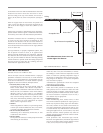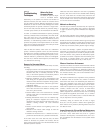
APPLICATIONS GUIDE: SYSTEM SMOKE DETECTORS
12
• Alternate Detector Mounting. Mounting alternate
detectors up to 3 feet (1 m) below the ceiling can
increase detection of small or smoldering fires when
the possibility of air stratification exists. Figure 23
illustrates such an installation. Specific designs for
such an alternate detection should be based upon an
engineering survey.
• Heating, Ventilating and Air Conditioning (HVAC)
effects on air flow and air stratification should be
determined and considered when planning detector
placement. In rooms where forced-air ventilation is
present, detectors should not be located where air
from supply diffusers could dilute smoke before it
reaches the detector. This may require additional
detectors, because placing detectors only near return
air openings may leave the balance of the area with
inadequate protection, especially when the Heating,
Ventilating and Air Conditioning (HVAC) system is not
operating.
• Detectors placed in an above-ceiling air handling space
should not be used as a substitute for open area pro-
tection, because smoke may not be drawn into the air
handling space when the ventilating system is shut
down. The detector will be less responsive to a fire
condition in the room below than a detector located on
the ceiling of the room below due to dilution and fil-
tering of the air in the air handling space before the
smoke reaches a detector. (See the discussion of detec-
tor placement in Section 4: Where To Place Detectors).
• Burn characteristics and the value of assets being pro-
tected influence the spacing of detectors and the
amount of protection provided in a specific room or
area. Refer to NFPA 72-1999, Section 2-3.6 for more
detailed information on spacing of detectors under
special applications. Likewise, if the contents are espe-
cially valuable, for example, sophisticated and expen-
sive machinery or irreplaceable records, detectors
should be placed closer together.
Detectors in Air Handling and Air Conditioning
Systems
See NEMA Guide for Proper Use of Smoke Detectors in
Duct Applications and NFPA 72, National Fire Alarm Code
for more specific information.
Detectors in Above-Ceiling Plenum Areas
Including Plenums Utilized as Part of the HVAC
System
Detectors should be placed in plenum areas (above ceiling
air handling space) in addition to the open area detectors
installed in the open areas below and duct detectors
installed in the ducts. Plenum detectors are required to be
listed or tested and approved for the air velocities within
the environment in which they are to be installed.
Detectors placed in plenums MAY NOT be used as a sub-
stitute for open area protection, because smoke may not be
drawn into the plenum when the ventilating system is shut
down. When the system is operating, the detector may be
less responsive to a fire condition in the room below than
will a detector located on the ceiling of the room below.
This may be due to blockage, dilution, and filtering of the
air prior to its arrival at the detector location in the plenum
area.
Since the air circulating through the plenums is usually at
higher velocities than would be prevalent in the room
below, detector spacing should be reduced.
Also, the dilution of the smoke in plenum spaces is an
important consideration when utilizing smoke detectors
rated for higher velocities. Therefore, plenum detectors
should be utilized to detect fire in the plenum but should
never be utilized as a substitute for duct detectors and
open area detectors.
Maintenance requirements of detectors exposed to unusu-
al velocities (above 300 fpm) are generally increased due to
the excessive dirt buildup and contamination present in
these environments.
Figure 23: High Ceiling Area
AA
3 ft. Minimum
Smoke Detectors at Ceiling
Smoke Detectors below Ceiling


















